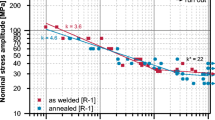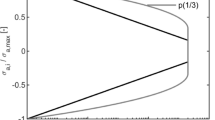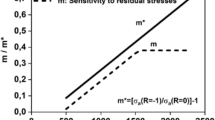Abstract
Typically, for a fatigue strength assessment of a welded structure, the influence of welding residual stresses has to be considered. An easy applicable approach is given within the framework of the IIW recommendations; the design S-N curves can be upgraded in case of medium or low residual stresses. A relaxation or redistribution of tensile residual stresses, which is often accompanied by an increase in fatigue life, cannot be considered. To obtain a better understanding of the residual stresses and their influence on the fatigue strength, fatigue tests have been performed on longitudinal stiffeners in as-welded and stress relieved state with both stress ratios R = −1 and R = 0. Local strains and stresses were measured using strain gauges and X-ray diffraction technique to get insight into the local material’s response due to global loading close to the weld toe. The crack initiation and propagation phase was detected by a camera. FE models were set up to reproduce the observed material behavior in the notch for the crack initiation phase. By numerical analysis it could be shown that, due to sharp notches at the weld toe with an average toe radius of r = 0.05 mm, a stress redistribution occurs during the first load cycle. This leads to a fatigue strength, which is, particularly at higher load amplitudes, independent from mean as well as from initial residual stresses. A comparison of fatigue data derived on longitudinal stiffeners from literature confirms this effect. For lower load amplitudes instead, mean and residual stresses gain more influence. In this investigation a reliable assessment of the crack initiation period could be performed with strain-based concepts using damage parameter PSWT for a mean stress assessment. All fatigue tests could be transformed into a single damage parameter PSWT-N curve with a low scatter if residual stresses as well as the distortion of the specimens are regarded.



















Similar content being viewed by others
References
Anami K, Miki C (2001) Fatigue strength of welded joints made of high-strength steels. Prog Struct Mater Eng 3:84–94
Bäumel A Jr, Seeger T (1990) Materials data for cyclic loading, Supplement 1. Elsevier, Amsterdam
Baumgartner J, Bruder T (2013) An efficient meshing approach for the calculation of notch stresses. Weld World 57: 137–145
Baumgartner J (2013) Schwingfestigkeit von Schweißverbindungen unter Berücksichtigung von Schweißeigenspannungen und Größeneinflüssen (Fatigue strength of welded joints under consideration of residual stresses and size effects), PhD thesis, Technical University of Darmstadt
Blom A (1987) Fatigue strength of welded joints subjected to spectrum loading. The Aeronautical Research Institute, Bromma
Blom A (1995) Spectrum fatigue behaviour of welded joints. Int J Fatigue 17:485–491
Bogren J, Martinez LL (1993) Spectrum fatigue testing and residual stress measurements on non-load carrying fillet welded test specimens, in Proceedings: Fatigue under spectrum loading and in corrosive environments, Technical University of Denmark
Burk J, Lawrence F (1978) The effect of residual stresses on weld fatigue life, FCP Report No. 29, University of Illinois
Dimitrakis S, Lawrence F (2001) Improving the fatigue performance of fillet weld terminations. Fatigue Fract Eng Mater Struct 24:429–438
Maddox S, Hopkin G, Holy A, Branco CM, Infante V, Baptista R, Schuberth S, Sonsino C, Küppers M, Marquis G, Lihavainen V-M, Gales A, denHerder A, Lont M (2007) Improving the fatigue performance of welded stainless steels, EUR 22809 EN, European Commission
Zilli G, Maiorana E, Peultier J, Fancia A, Hechler O, Raunert T, Maquoi R (2008) Application of duplex stainless steel for welded bridge construction in an aggressive environment, European Commission
Farajian M, Nitschke-Pagel T, Dilger K (2010) Mechanism of residual stress relaxation and redistribution in welded high strength steel specimens under mechanical loading. Weld World 54:366–375
Gurney T (1960) Influence of residual stress on fatigue strength of plates with fillet welded attachments. Br Weld J 7:415–431
Gurney T (1962) Further fatigue tests on mild steel specimen with artificially induced residual stresses. Br Weld J 8:609–613
Gurney T (1977) Residual stresses in welded constructions and their effect, The Welding Institute
Haagensen PJ, Alnes O (2005) Progress Report on IIW WG2 Round Robin Fatigue Testing Program on 700 MPa and 350 MPa YS Steels, International Institute of Welding, XIII-2081-05
Hensel J, Nitschke-Pagel T, Schönborn S, Dilger K (2012) Factors affecting the knee point position of S-N curves of welds with longitudinal stiffeners, International Institute of Welding, XIII-2441-12
Huther I, Pollet F, Lieurade H (2002) Effect of the restraining conditions during welding on fatigue strength, International Institute of Welding XIII-1952-02
Huther I, Suchier Y, Lieurade H (2006) Fatigue behaviour of longitudinal non-load-carrying joints improved by burr grinding, TIG dressing, International Institute of Welding, XIII-2108-06
Higahsida Y, Burk J, Lawrence FV (1978) Strain-controlled fatigue behavior of ASTM A36 and A514 grade F steels and 5083-O aluminum weld materials. Weld J 57:334–344
James M, Hughes D, Hattingh D, Mills G, Webster P (2009) Residual stress and strain in MIG butt welds in 5083-H321 aluminium: As-welded and fatigue cycled. Int J Fatigue 31:28–40
Jeong WH, Seung HH, Byung CS, Jae HK (2005) Fatigue crack initiation and propagation life of welded joints. Key Eng Mater 297–300:781–787
Lee C-H, Chang K-H, Jang G-C, Lee C-Y (2009) Effect of weld geometry on the fatigue life of non-load-carrying fillet welded cruciform joints. Eng Fail Anal 16:849–855
Maddox S (1982) Influence of tensile residual stresses on the fatigue behavior of welded joints in steel, ASTM STP 776. Am Soc Test Mater 63–96
Maddox S (2007) Improving the fatigue strength of toe ground welds at the ends of longitudinal attachments, International Institute of Welding, XIII-2156-07
Marquis G, Björk T (2008) Variable amplitude fatigue strength of improved HSS welds, International Institute of Welding, XIII-2224-08
Martinez LL, Blom AF (1995) Influence of life improvement techniques on different steel grades under fatigue loading. Fatigue Des III
Martinez LL, Lin R, Wang D, Blom AF (1997) Investigation of residual stresses in as-welded and TIG-dressed specimens subjected to static/spectrum loading, Proceedings of the North European Engineering and Science Conference, (NESCO): “Welded High-Strength Steel Structures”
Miki C, Tai M (2012) Fatigue strength improvement of out-of-plane welded joints of steel girder under variable amplitude loading, International Institute of Welding, XIII-2445-12
Mori T, Inomata T (2003) Influence of grinding method on fatigue strength of out-of-plane gusset welded joints, International Institute of Welding, XIII-1970-03
Neuber H (1968) Über die Berücksichtigung der Spannungskonzentration bei Festigkeitsberechnungen. Konstruktion 20:245–251
Paetzold H, Petershagen H (1990) The effect of post-weld explosion treatment on the fatigue strength of plates with longitudinal stiffeners, International Institute of Welding, XIII-1369-90
Ramberg W, Osgood WR (1943) Description of stress–strain curves by three parameters, NACA technical notes, No. 902, National Advisory Committee for Aeronautics
Seeger T, Beste A (1977) Zur Weiterentwicklung von Näherungsformeln für die Berechnung von Kerbbeanspruchungen im elastisch-plastischen Bereich (Improvement of approximation formulae for calculating notch stresses and strains in the elastic–plastic range), in: Fortschrittsbericht der VDI Zeitschriften: Kerben und Bruch (Notches and fracture), Reihe 18, Nr. 2, VDI-Verlag
T Seeger (1996) Stahlbau Handbuch 1 Teil B. Stahlbau-Verlagsgesellschaft mbH Köln
Smith K, Watson P, Topper T (1970) A stress–strain functions for the fatigue on materials. J Mater 5:767–778
Sonsino CM, Böhme D, Kulka C, Helwig R (1987) Slope of the S-N curve and high-cycle fatigue behaviour of longitudinal stiffeners in as-welded and stress relieved states, International Institute of Welding, XIII-1242-87
Sonsino C, Kaufmann H, Wagener R, Fischer C, Eufinger J (2011) Interpretation of overload effects under spectrum loading of welded high-strength steel joints. Weld World 55:66–78
Trufyakov V (1958) Welded joints and residual stresses. Br Weld J 5:491–498
Wang T, Wang D, Huo L, Zhang Y (2009) Discussion on fatigue design of welded joints enhanced by ultrasonic peening treatment (UPT). Int J Fatigue 31:644–650
Yamamoto N, Mouri M, Okada T, Mori T (2012) Analytical and experimental study of the thickness effect to fatigue strength, International Institute of Welding, XIII-2434-12
Acknowledgment
The investigations presented here were supported by financial funding from Federal Ministry of Economics and Technology BMWi over the AiF e.V. (Arbeitsgemeinschaft industrieller Forschungsvereinigungen “Otto von Guericke” e.V.) under the grant 15.913N. Technical and scientific support during the project was given by the German Welding Society DVS (Forschungsvereinigung Schweißen und verwandte Verfahren e. V.) in the working group FA9. The authors would like to thank the AiF, the DVS, and the members of the FA9 for their support.
The stress relieve treatment as well as the X-ray measurements were performed by Fraunhofer IWM. We would like to thank Dieter Siegele for the good cooperation.
Author information
Authors and Affiliations
Corresponding author
Additional information
Doc. IIW-2396, recommended for publication by Commission XIII “Fatigue of Welded Components and Structures”
Rights and permissions
About this article
Cite this article
Baumgartner, J., Bruder, T. Influence of weld geometry and residual stresses on the fatigue strength of longitudinal stiffeners. Weld World 57, 841–855 (2013). https://doi.org/10.1007/s40194-013-0078-7
Received:
Accepted:
Published:
Issue Date:
DOI: https://doi.org/10.1007/s40194-013-0078-7




